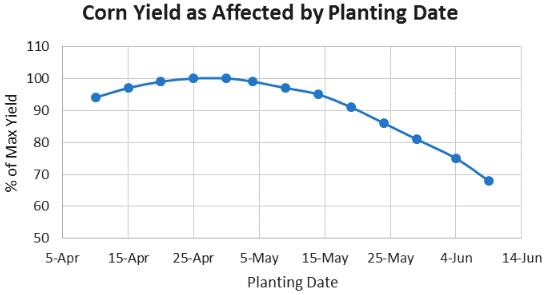By Zachary Larson
The past 30 days brought above average precipitation to most of the state, and with many places receiving over 2 inches of rain in the past week, late planting will be reality for many. This week’s USDA Crop Progress and Condition Report estimates that 26% of the state’s corn crop was planted as of May 12th, compared to the 5-year average of 38%, with tillage operations slightly ahead of the average. While late planting often brings concerns of reduced yields and switching hybrids, there are many pieces to the puzzle that ultimately affect the number of bushels in the bin come fall.
Planting Date
The first thing to consider is the planting date. Planting date does influence corn yield (figure 1), with optimum planting dates ranging from April 15th to May 1st in the southeastern corner of the state to May 15th to 25th in the northern tier and Laurel Highlands. However, those differences are relative differences, assuming all other growing conditions being equal. When looking at the entire growing season, we have many factors to consider and planting date likely means little when it comes to understanding the total amount of yield variability form year to year. A look at
planting date data from Ohio helps to demonstrate this point, showing years of late planting where average corn yields were both higher and lower than historical averages.

Figure 1: Corn Yield as Affected by Planting Date for Corn Maturity Zone 3. A 30-day (approx.) window exists where corn can achieve 95% or more of maximum yield potential. Once the planting date is about two weeks beyond the ideal date (as shown here as May 15th) the amount of potential yield loss per day begins to increase.
Switching Hybrids
At this point there is still adequate time for full-season hybrids to reach physiological maturity by typical first frost dates. And while the differences in yield between full-season and short-season hybrids have been blurred in some cases, full-season hybrids may still out-yield their short-season counterparts. What makes this possible is the ability for full-season hybrids to “adapt” to the shorter season by requiring fewer growing degree days to mature than what they’re rated for. Research from
Ohio and Indiana show that a hybrid planted 30 days late can reduce the necessary growing degree days to reach black layer by 6.8 degrees per day of late planting. This suggests that a hybrid that takes 2600 growing degree days (GDDs) to mature can do so with 200 fewer GDDs when planted 30 days late.
However, a tradeoff still exists, with full-season hybrids potentially taking longer to dry down than their shorter season counterparts. This could be entirely dependent on fall conditions though, with a warm and dry fall favoring smaller differences in drydown between full and short season crops.
Planting Conditions Still Matter
While one can stress over potential yield impacts from late planting, the impact from poor corn emergence is more concrete. The yield penalty from inconsistent emergence is widely documented in many studies, a summary of which can be found at "
Planting Date, Temperature, Spacing, and Emergence: What Really Matters? ," and the risks of sidewall compaction, poor seed placement and improper seed trench closing should be considered before putting the planter in the ground. Therefore, it is still best to wait for good planting conditions and stay the course with good practices. Particular attention should be paid to downpressure settings, soil buildup on gauge wheels and closing wheel adjustment. Shortcuts such as planting at a shallower depth should be avoided, as it can result in more variable emergence.
While we’re wetter and a bit behind we would like to be, by no means is it time to panic, as there are many things that will determine the success of our 2019 corn crop. At this time one can take solace knowing that we’re not that far from historical trends, and a decent period of good weather may quickly change our outlook.